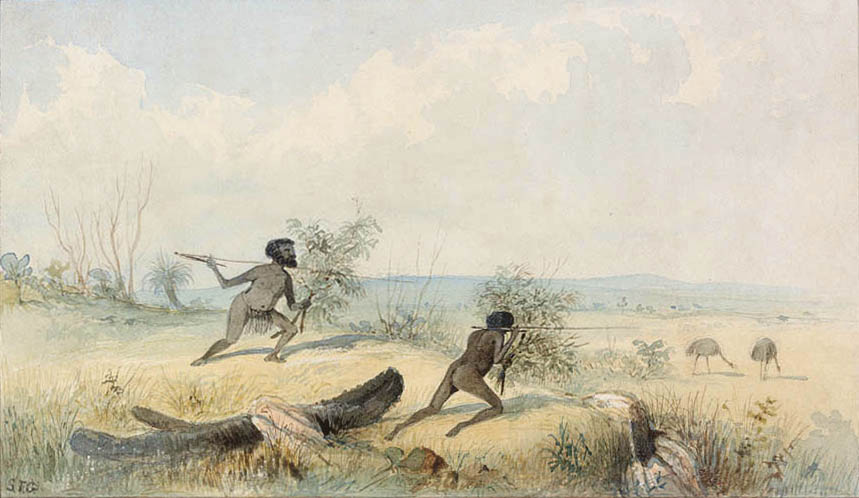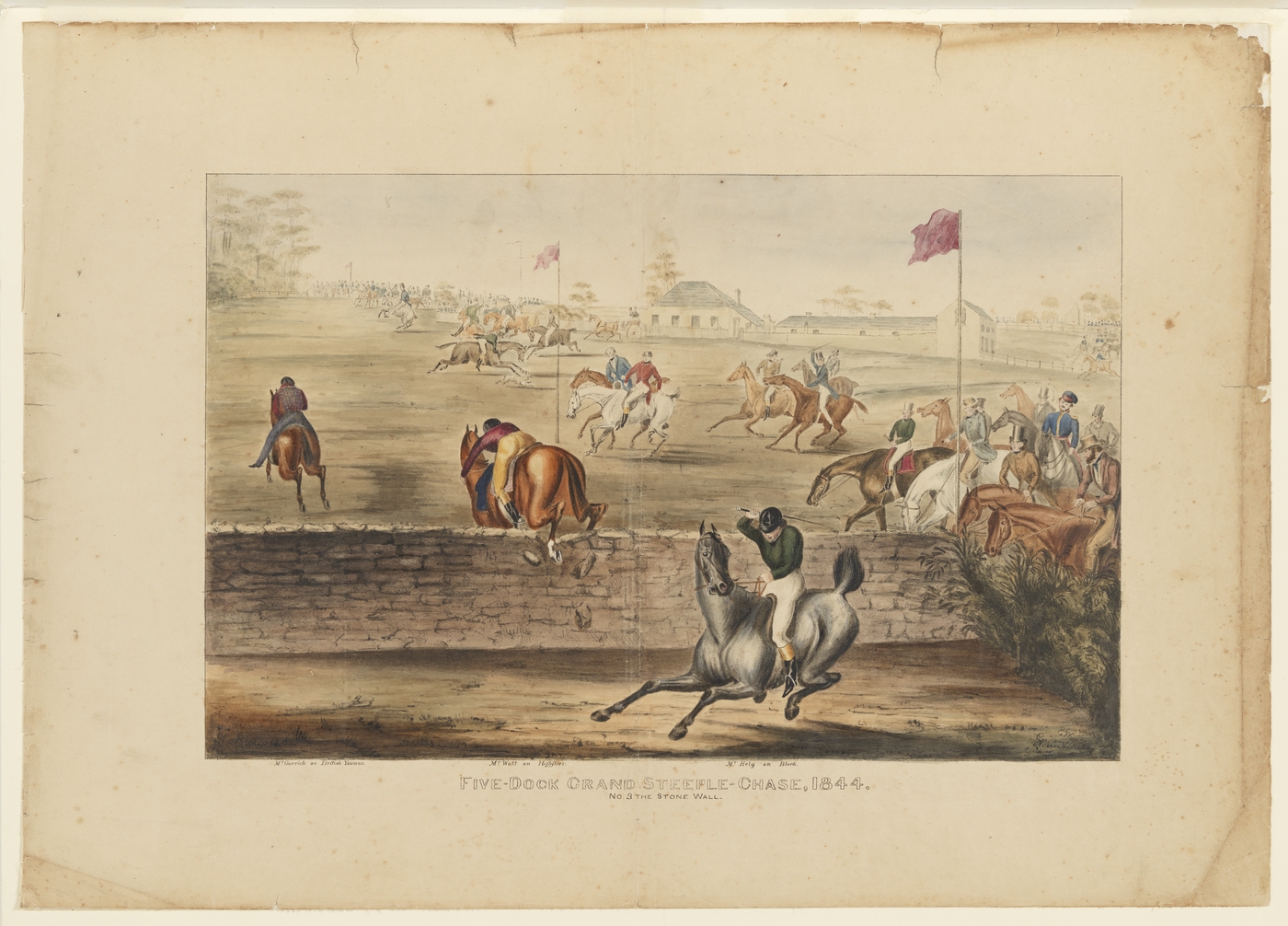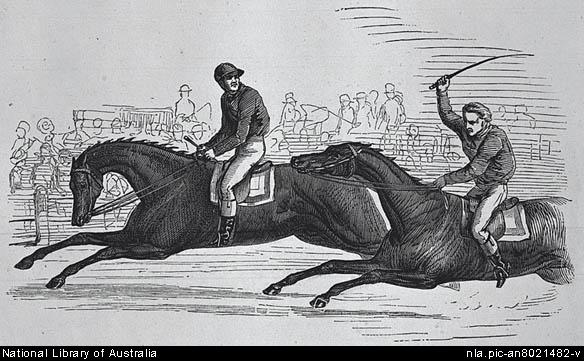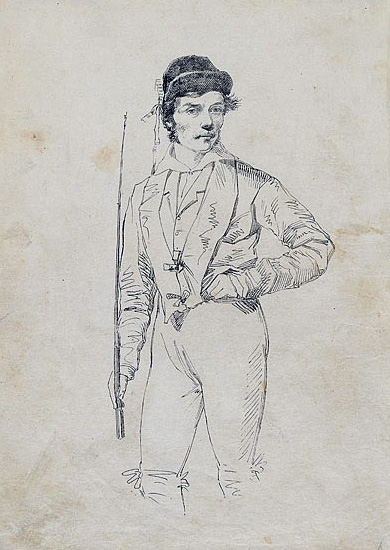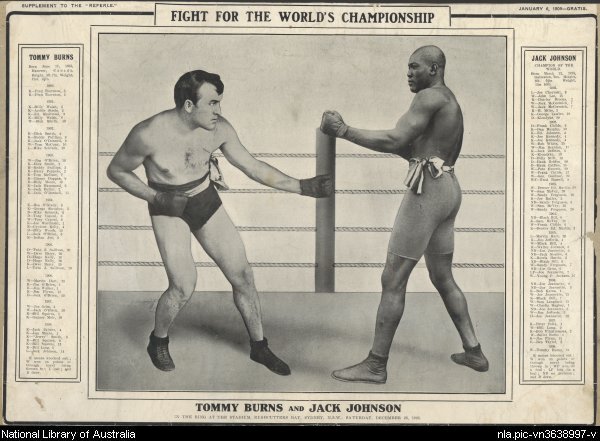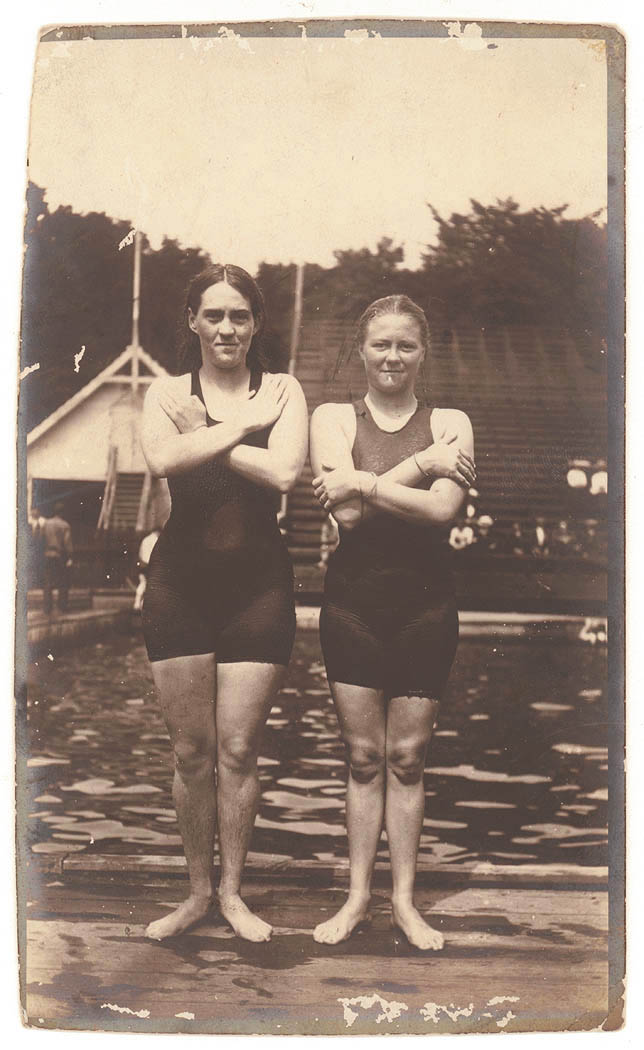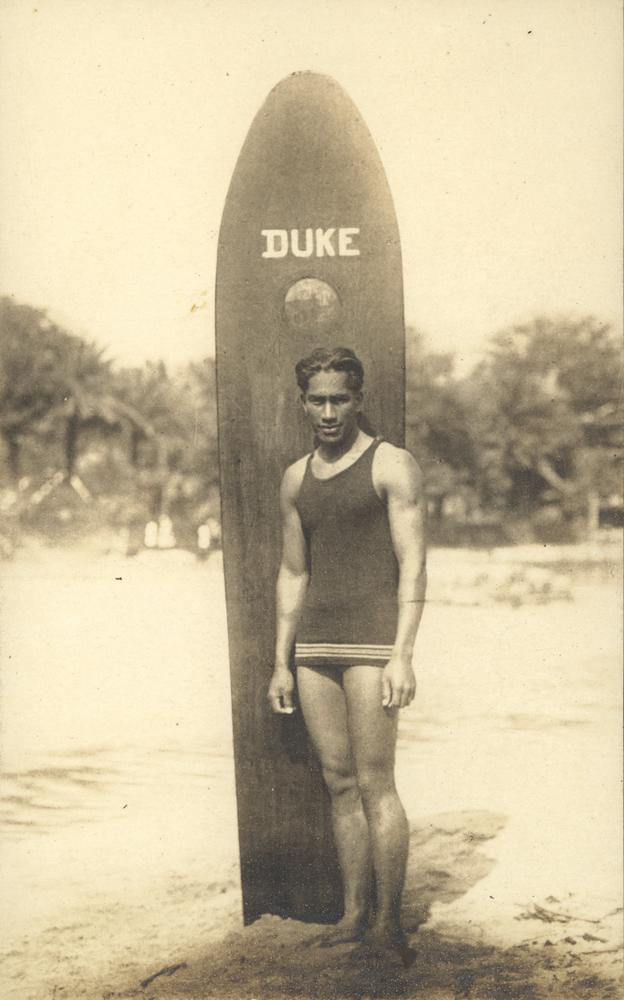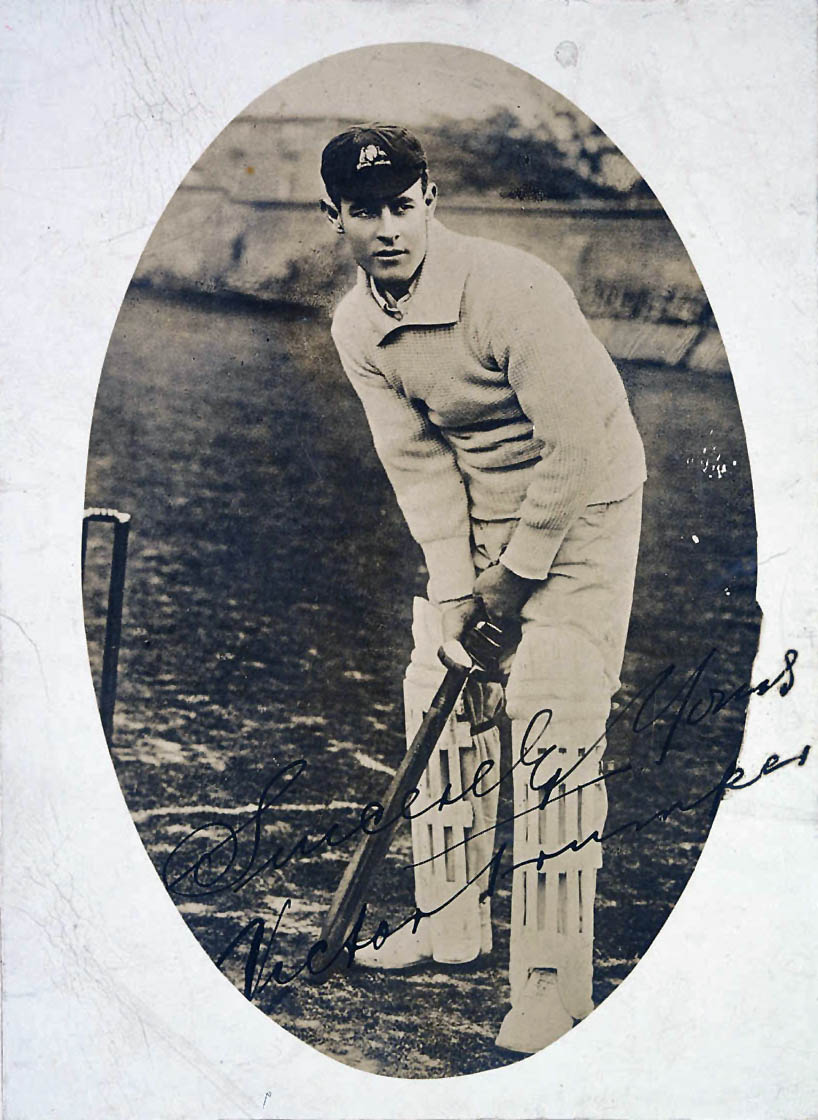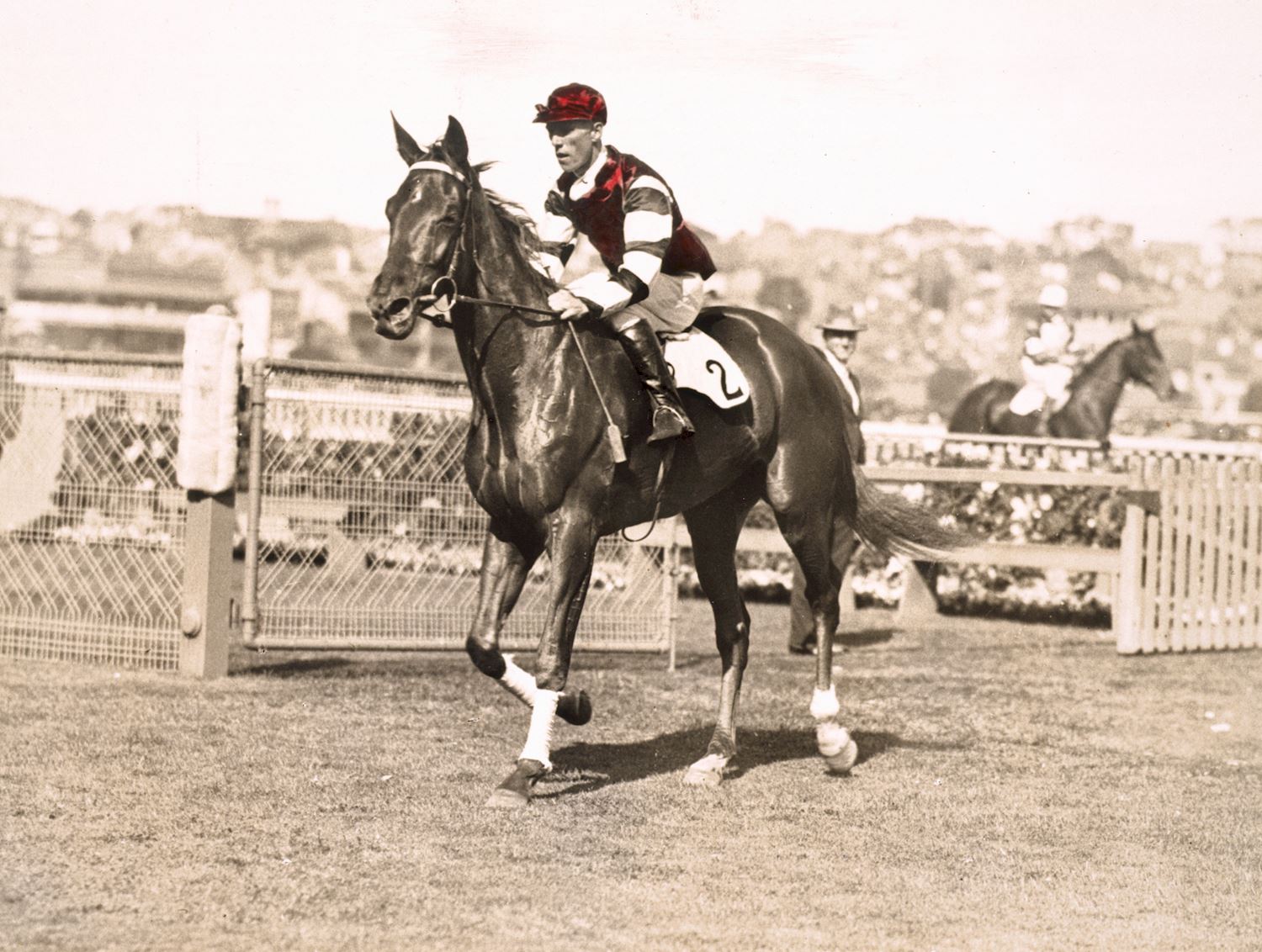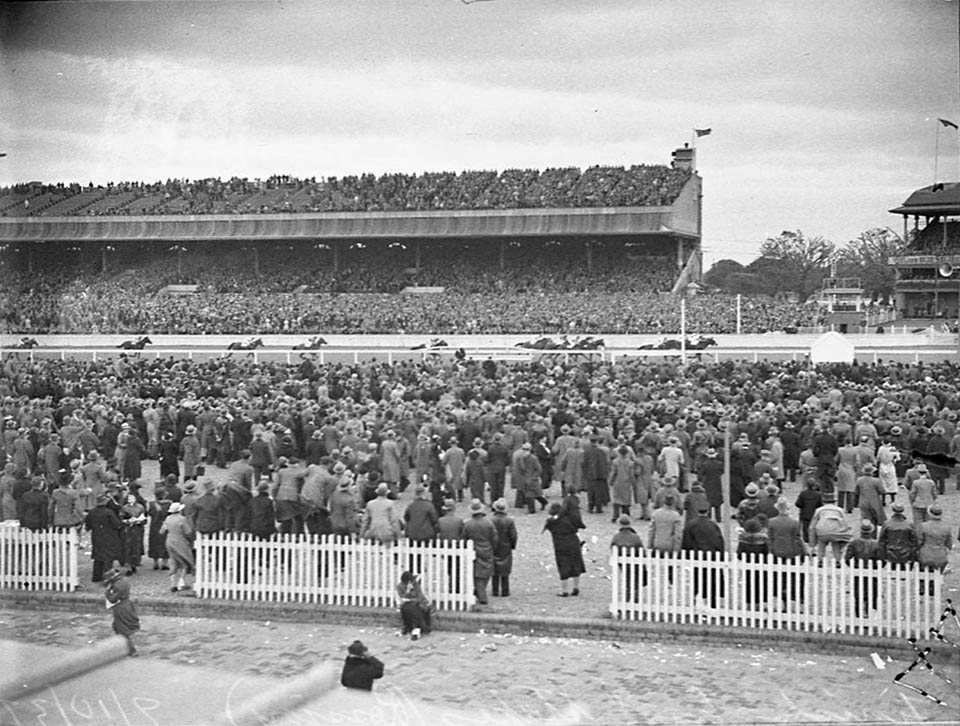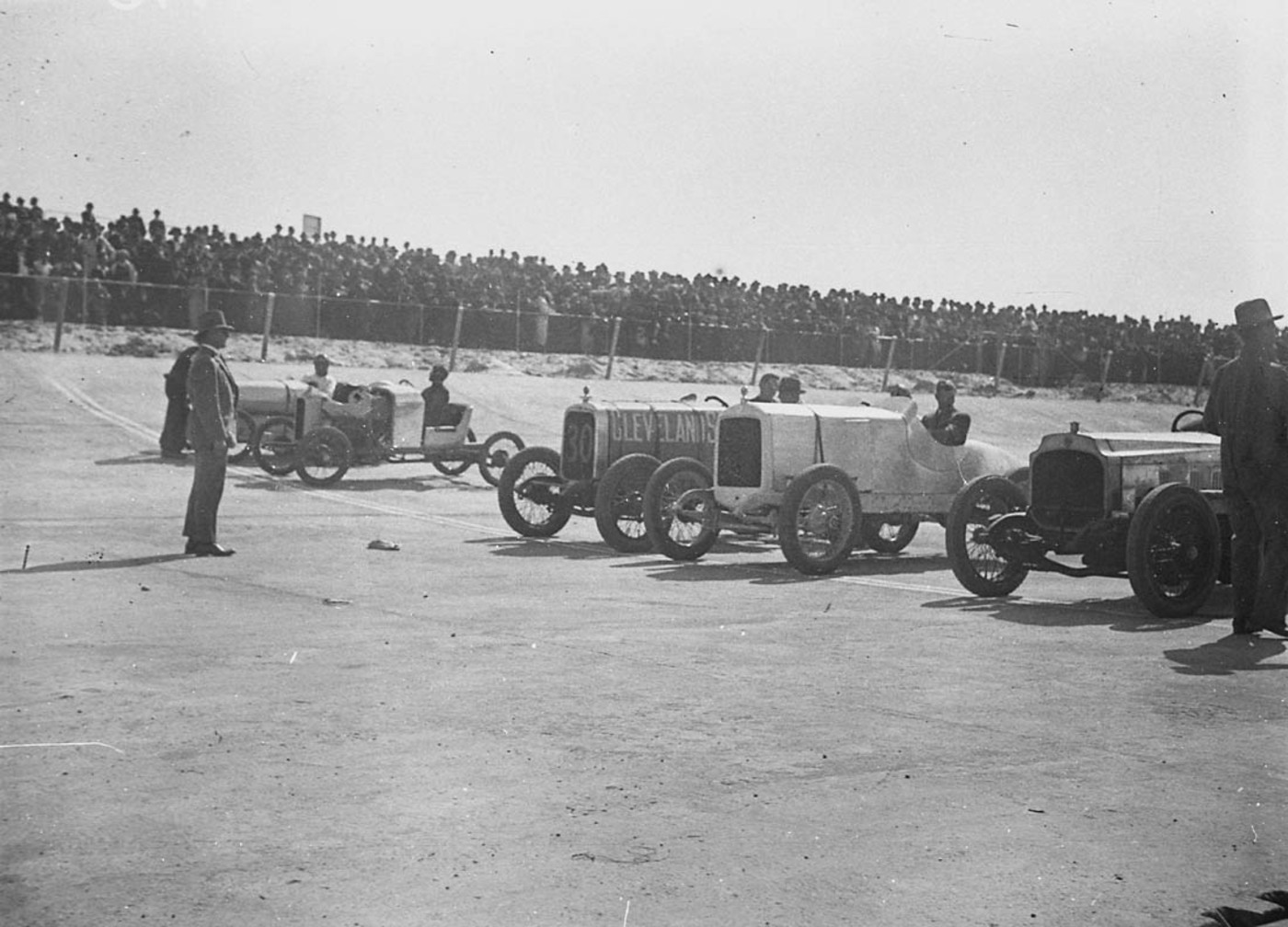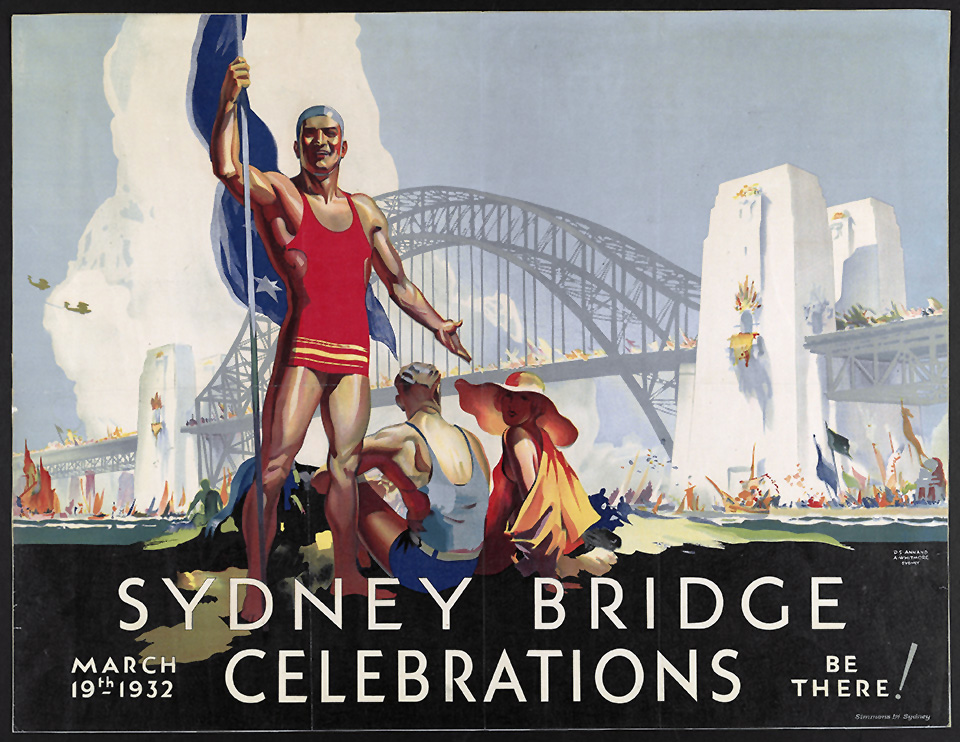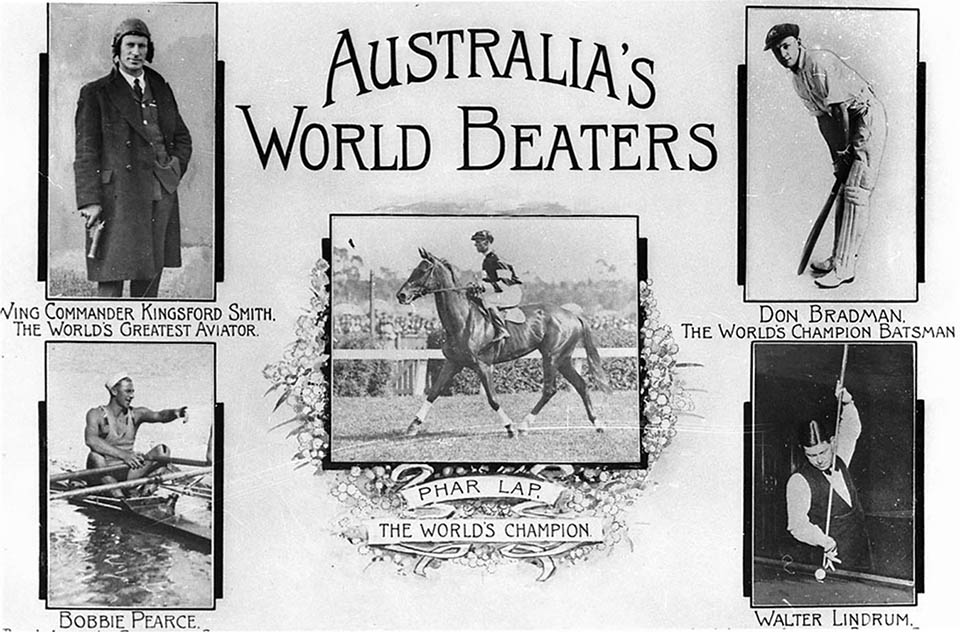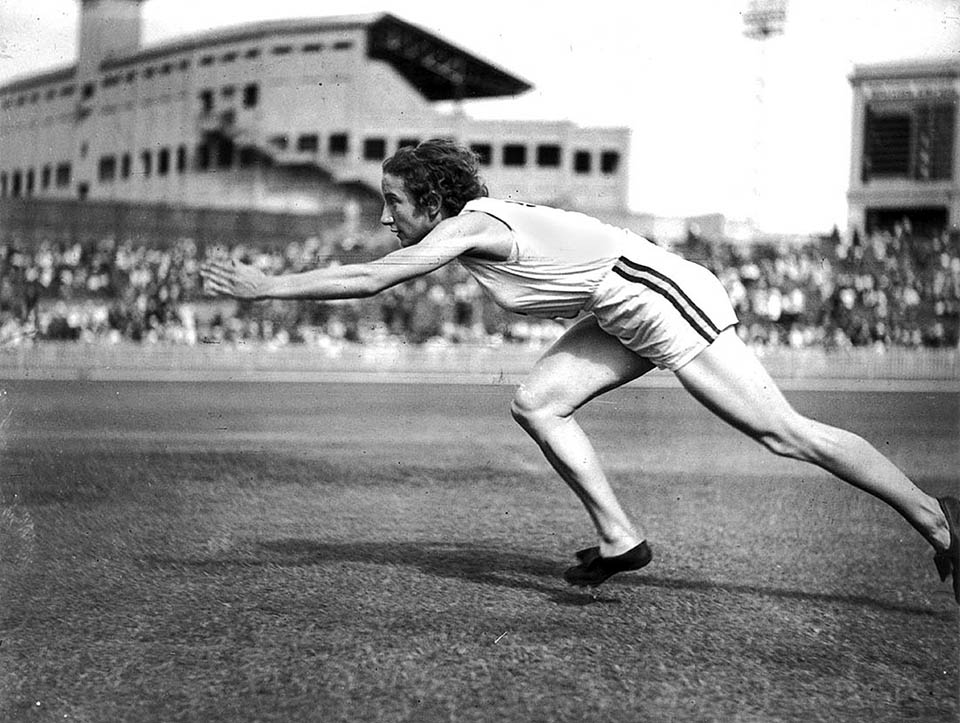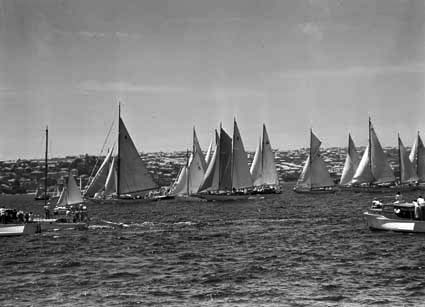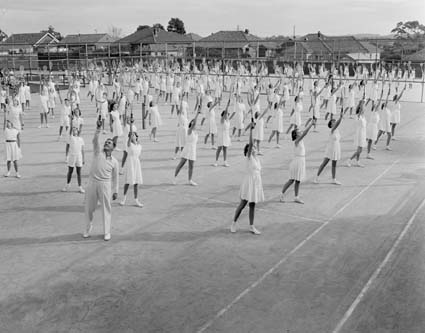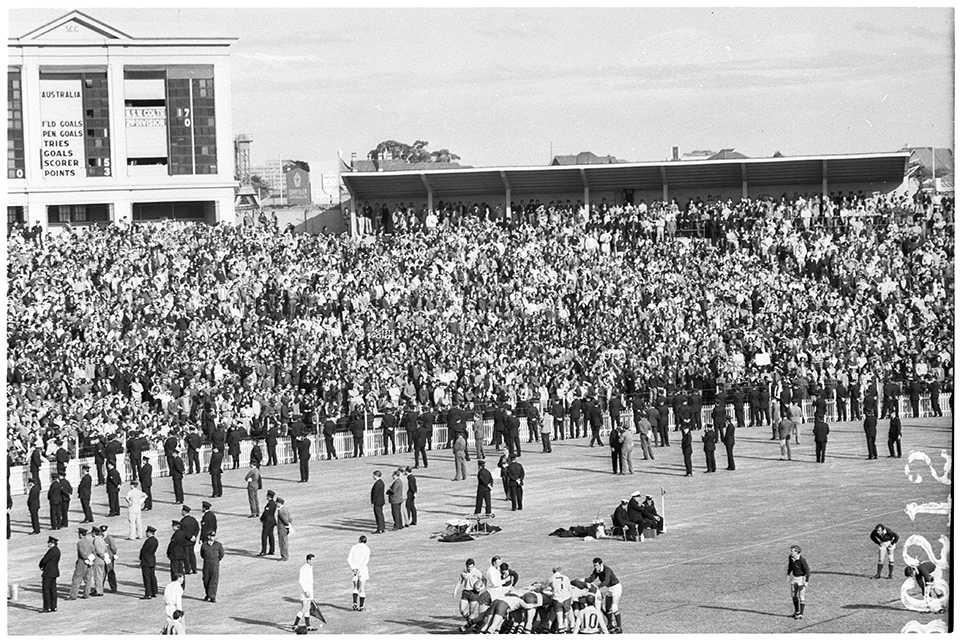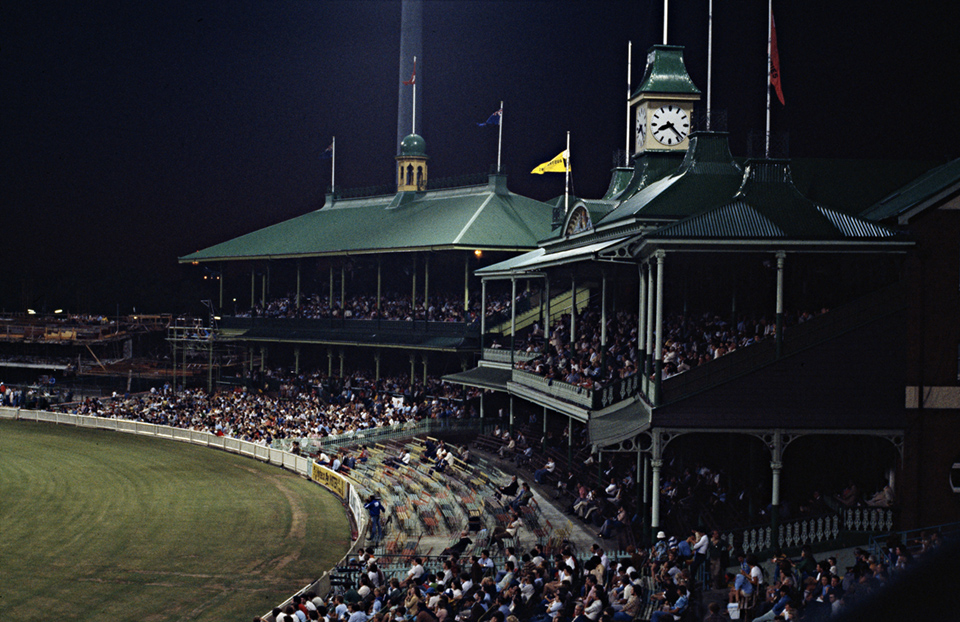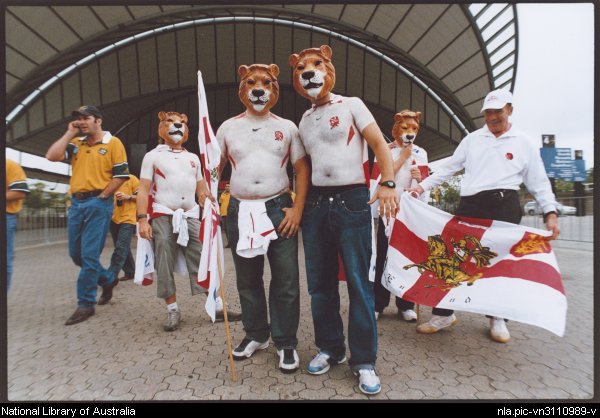The Dictionary of Sydney was archived in 2021.
Sport
Citation
Persistent URL for this entry
To cite this entry in text
To cite this entry in a Wikipedia footnote citation
To cite this entry as a Wikipedia External link
Sport
[media]The Aboriginal people of the Sydney basin indulged in sporting activities, including swimming, fishing, canoeing, wrestling, spear-throwing contests and hunting. However, Aboriginal sporting activity was never a separate activity with its own rules, time and space as it had become in western society. Sport for Aboriginal people was inseparable from ritual and daily life.
1788–1850
While many migrants to the colony brought with them a passion for sport, the necessity of survival and the lack of facilities, equipment and money restricted sporting opportunities. Sport in Sydney before 1850 was informal, irregular, violent, often involved animal cruelty and was almost exclusively male.
Sports involving few resources, such as bare-knuckle boxing, wrestling and cockfighting, appealed to Sydney's predominantly convict population. Boxing bouts could be organised in any public space and at a moment's notice. The first recorded bout in Sydney took place on 8 January 1814. Combats continued until one of the boxers was exhausted or seriously injured.
[media]Horseracing was Sydney's first organised sport and there was a race ground near Richmond by 1806 and match races at Parramatta by April 1810. The officers of the 73rd regiment organised a three-day race meeting at Hyde Park under the patronage of Governor Lachlan Macquarie, on 15, 17 and 19 October 1810. They repeated this annual event in 1811, 1812 and 1813. The Sydney Turf Club was founded in 1825 but in 1827 became the focal point for a dispute between the emancipist William Wentworth and Governor Ralph Darling.
[media]The leaders of Sydney horseracing struggled to find a suitable course, moving from Hyde Park to Double Bay, Parramatta, Camperdown, Petersham and Homebush over the next four decades. When the Australian Jockey Club was formed in 1842, it operated from the Homebush course.
The Australian Cricket Club, formed in 1826, was Sydney's first cricket club. [media]Matches against other pub-based and military clubs were played regularly during the 1830s and 1840s at Hyde Park, which served for four decades as a sports ground and town common, where sheep grazed, soldiers paraded and the general population strolled. Cricketers competed for space with practitioners of other sports, such as shinty and quoits.
Publicans were the principal patrons of sport in this era and many cricket clubs were based on pubs where they held their meetings and drank after matches. The Australian Cricket Club was based at the Australian Hotel in George Street, Sydney, and the publican, Edward Flood, was a member of the team. Resourceful publicans also created billiard saloons where they organised challenge matches that involved substantial stakes.
Aquatic sports – fishing, boat-racing and swimming – were prominent from an early stage. Marines constructed swimming enclosures on the harbour, while boat races for a stake were reported as early as 1810.
Sydney sport before 1850 resembled that of pre-industrial England with rural rather than urban sports predominating. Shooting and hunting clubs were organised and men hunted kangaroos and dingoes before Dr Robert Wardell imported deer to stock his own extensive estate at Marrickville to enhance hunting parties.
[media]William Francis King, the 'Flying Pieman', was a self-made character of Sydney sport in the 1840s. This colourfully bedecked pedestrian undertook bizarre feats such as his walk from Campbelltown to Sydney between midnight and 9 am carrying a 70-pound (32-kilogram) dog. Many of his exploits were planned in public houses where King worked as a barman.
[media]The gelding Jorrocks, which won 31 out of 32 races from 1846 to 1849, was one of the first stars of Sydney sport. His portrait was one of the first to appear in the press in 1847.
Women had few sporting options before 1850 other than as spectators at cricket and horseracing, though swimming was one possibility after Thomas Robinson opened separate baths for men and women at Woolloomooloo Bay in the 1830s.
1850–1914
With the expansion of the economy and population from the 1850s, sport became more organised and more important in Sydney's physical and social landscape. Sport captured the imagination of the urban working class, who had more money to invest in sport and more time to indulge in it with the progressive extension of the Saturday half-holiday. Sport also reflected the growing class and gender divide with club restrictions and even segregation. The public interest in sport was whetted by the rise of intercolonial and international sport as a result of improved communications and transport.
Randwick became the focus of Sydney racing and the headquarters of the Australian Jockey Club after Randwick racecourse was reopened in 1860 on the same site as the Sandy Race Course, which had operated for a few years from 1833. By the 1890s, Sydney had a network of racecourses including Canterbury, Moorefield, Warwick Farm, Sydney Driving Park and Lillie Bridge – the latter featuring pony racing and trotting. Sydney racing operated on a tripartite model: thoroughbred racing on registered courses, pony racing on registered courses and pony races on unlicensed courses. Pony racing filled the gaps caused by a shortage of thoroughbred horses. Such was the proliferation of courses by the turn of the century that there was a race meeting held on virtually every weekday as well as several on Saturday.
[media]The first intercolonial cricket match in Sydney was staged between New South Wales and Victoria at the Domain in 1857. The New South Wales Cricket Association was formed to administer cricket in 1859. A team of English professionals toured in 1862 and played a Sydney XXII at the same ground. The growth in cricket's popularity encouraged the development of enclosed grounds where spectators could be charged for admission. The Albert Ground at Redfern was opened in 1864 and, after it was closed, the Sydney Cricket Ground was opened in 1878 and became the city's premier sports ground, hosting a multitude of sports including cricket, cycling, football, tennis and athletics. The Sydney Cricket Ground was the venue for the first Test played in Sydney, from 17–21 February 1882. An Australian cricket team, spearheaded by Sydneysider Fred Spofforth, had completed a successful tour of Britain in 1878, defeating the powerful Marylebone Cricket Club.
[media]Rugby was the first football code to gain a toehold in Sydney with the first recorded game taking place at Hyde Park in 1865. The initial impetus for the code came from middle-class students as well as old boys of Sydney University and schools such as The King's School and Newington. The Southern Rugby Football Association was formed in 1874 to administer the code. The first recorded match of soccer was played at Parramatta Common on 14 August 1880.
[media]Professional sculling became an immensely popular sport from the 1850s. Edward Trickett was the first Australian to win a world title on the River Thames in 1876 and received a hero's reception on his return to Sydney. When he defended his title on the Parramatta River in June 1877, Trickett was followed by 70 steamers and numerous small craft, and a crowd of over 50,000 watched from the river banks. Henry Searle was another sculler who won the world title on the Parramatta River in 1888 and defended his title in London in 1889. He contracted typhoid on the return trip to Australia and died in Melbourne. Following a public subscription, a broken marble column on a granite base was erected in his memory in Parramatta River, off Henley, at the finishing line of sculling events.
Many new sports appeared in Sydney over the next few decades including lawn bowls, lawn tennis, golf and cycling. In 1876, John Young, a wealthy landowner and developer, constructed a green on his own property, Kentville, in what was to become the Sydney suburb of Annandale, and used bowls to help sell real estate. The first bowls intercolonial, between New South Wales and Victoria, was played at Young's home green in 1880.
[media]Lawn tennis was initially a form of genteel recreation that was part of garden party entertainment for men and women. It soon developed as a competitive sport which had a close association with cricket. The Sydney Lawn Tennis Club, established in 1880, was linked to the Sydney Cricket Ground Trust and tennis matches were played in the centre of the Sydney Cricket Ground. The success of Australasia in the Davis Cup competition, which began in 1900, added to the prestige of the sport. Australasia defeated the United States by five rubbers to nil in the 1909 Davis Cup, which was staged in Sydney.
Golf began as an exclusive and amateur sport. The Australian Golf Club, the first formal golf club in Sydney, was established in 1882 and the Royal Sydney Golf Club in 1893. The membership reflected the composition of establishment Sydney.
[media]The Sir Joseph Banks Hotel at Botany was a focal point for professional running in the 1880s and it developed the first professional track in Australia – cinders separated by grass lanes and ringed by gaslights. The prize money was sometimes as much as £500. The boom in professional running ended in the 1890s, when some of the runners 'ran dead' (running slower to improve their handicaps), bringing the sport into disrepute.
Although the Sydney Bicycle Club was formed in 1879, it was not until the development of the pneumatic-tyre safety bicycle in the 1890s that there was a cycling boom, with the sport appealing both to men and women. A number of cricket grounds, including the Sydney Cricket Ground, included cycle tracks around their perimeters.
With the growth of Sydney's population and the increasing coverage of sport in the press, larger crowds attended suburban, intercolonial and international sport. A crowd of 51,211 – approximately one tenth of the city's population – watched New South Wales play rugby against New Zealand in 1907. Australia, represented by the New South Wales rugby team, won the inaugural rugby gold medal at the 1908 London Olympic Games. Rugby had grown in popularity and experienced an influx of working-class players in newly created suburban clubs.
The celebrated split in Sydney rugby began in 1907 and culminated in the launch in 1908 of a new, more professional code known as rugby league, which was based in inner-city working-class suburbs. The mean-spirited attitude of the amateur-minded rugby officials, who were unwilling to pay players compensation for lost wages and injuries, provided the impetus for the new code. To make the game more entertaining the founders of rugby league reduced the size of teams from 15 to 13 and scrapped rucks, mauls and lineouts. The backing of hotelier and prominent entrepreneur Sir James Joynton Smith was also critical for league's survival.
[media]Another entrepreneur, Hugh D ('Huge Deal') McIntosh, realising the drawing power of race, staged a world title bout between African-American Jack Johnson and Canadian Tommy Burns, the 'great white hope'. Some 20,000 jammed the newly created Sydney Stadium at Rushcutters Bay, and another 20,000 waited outside for news of the event. Macintosh himself refereed the fight.
Freddy Lane, who learnt to swim in Lavender Bay, won two gold medals at the 1900 Paris Olympic Games and Sydney sprinter Stan Rowley achieved one gold and three bronze medals.
Women struggled to gain public acceptance in many sports. Although a match was played between two women's cricket clubs at the Sydney Cricket Ground in 1886, women cricketers were largely ignored or ridiculed. [media]Swimmers Sarah 'Fanny' Durack and Mina Wylie were keen to participate in the inaugural 100 metres for women at the 1912 Stockholm Olympic Games but, unlike the men, received no funding from swimming officialdom. It was only a last-minute public subscription that enabled the two swimmers to go to Stockholm, where Durack won the event and Wylie finished second. Field hockey was one team sport considered acceptable for women and girls and the sport was played in private schools and at the University of Sydney.
Sports stars were elevated in the media in the decades before and after Federation as ideal Australians. These included cricketer Victor Trumper, rugby union and league player 'Dally' Messenger, and boxers Les Darcy and Albert Griffiths ('Young Griffo'). Famous swimmers included the Cavill family, Fanny Durack, Annette Kellerman and Barney Kieran.
Surf bathing became immensely popular in the first decade of the twentieth century after restrictions on daylight bathing were removed. The Bondi Surf Bathers' Life Saving Club, formed in February 1907, was the first such club formed in the country. The Surf Bathing Association of New South Wales was subsequently formed in October 1907. [media]The visit of the Hawaiian star Duke Kahanamoku to Freshwater Beach in 1914 did much to stimulate surfboard riding.
1914–18
There was much debate at the beginning of World War I about whether elite sport should continue during wartime. Many middle-class commentators asserted that sport should cease and that sportsmen should enlist for the 'great game'. Many middle-class-run sports, such as cricket, rugby union and golf, ceased regular competition except for the odd patriotic match to raise funds for the war effort. Horseracing continued on a restricted basis.
However, the working-class sport of rugby league continued its weekly round of matches and gained ground over rugby union as a result. Major fights continued at Sydney Stadium and the popular Maitland-born boxer Les Darcy won a number of bouts in Sydney to become middleweight and heavyweight champion respectively in 1915 and 1916. When he fled the country surreptitiously to further his boxing career the day before the conscription referendum of 1916, he was branded by some as a 'slacker' and even a 'deserter' but lauded by others as an anti-conscription symbol. Darcy died in Memphis USA on 24 March 1917.
[media]Victor Trumper, the 'crown prince of cricket's golden age', died of Bright's disease on 28 June 1915, at the age of only 37. His premature death, just two months after Gallipoli, evoked widespread public grief and over 100,000 mourners attended his funeral. He is buried in Waverley Cemetery.
1918–39
[media]In the interwar era, spectator sport boomed as never before, with record crowds at major sports such as cricket, the various football codes and horseracing. A public appetite for sport was further whetted by the introduction of radio from 1923. The interwar period witnessed the emergence of charismatic stars such as cricketer Donald Bradman, billiards player Walter Lindrum and racehorse Phar Lap, whose deeds helped relieve the gloom of the Depression in the early 1930s. The interwar period also marked the expansion of motor sports with automobiles and motorcycles, and new sports such as squash.
[media]Cricket was more popular in the late 1920s and 1930s than in any other period. Bradman undoubtedly drew large crowds to cricket. The boy from Bowral scored a century on his debut for New South Wales in 1927, before becoming an unequalled run-getter. Even as the Depression loomed, a record crowd of 58,446 attended the Ashes Test at the Sydney Cricket Ground on 15 December 1928. Bradman's appeal was heightened because his mammoth scores also coincided with the Bodyline series (when he was the hero and English captain Douglas Jardine the villain) and the arrival of ball-by-ball radio coverage in the 1930s. Bradman left Sydney after 1934 to pursue business opportunities in Adelaide. 'Yabba' (Stephen Harold Gascoigne), a Balmain rabbit-oh, was a self-made character who became famous as a cricket barracker. He enlivened play with witty comments in a stentorian voice that could be heard across the Sydney Cricket Ground.
Such was the popularity of cricket in the 1930s that even women's cricket gained prominence, with the first series between Australia and England taking place in the 1934–35 season. The second Test at the Sydney Cricket Ground attracted a sizeable crowd.
Rugby league was the dominant football code in Sydney in the 1920s and 1930s. A crowd of 45,000 attended the Australia–England Test match at the Sydney Cricket Ground on 14 July 1928.
Chinese soccer teams toured Australia in 1923, when a Sydney Cricket Ground crowd of 47,500 watched Australia play, and again in 1927. English teams toured in 1925 and 1937.
[media]With radio broadcasts from the mid-1920s and increased media coverage, horseracing boomed in the interwar years with crowds as large as 90,000 attending Randwick racecourse, such as on Derby Day in 1922. There was also an upsurge in illegal off-course betting with SP bookmakers taking advantage of radio broadcasts, which began in 1923, and the expansion of private telephones. The Warwick Farm course, purchased by the Australian Jockey Club in 1922, was virtually rebuilt and reopened in 1925. The career of Phar Lap, a racehorse who became a national celebrity, was launched when he won the Rosehill Guineas in 1929. The development of trotting was slower because of competition from the galloping and pony-racing clubs. However, popular country pacer Walla Walla created a number of records at Harold Park (previously known as Lillie Bridge and Epping) in the early 1930s. A mechanical hare was used for the first time in greyhound racing at Harold Park in 1927. Greyhound racing emerged, by the 1930s, as a popular sport for the working classes. The Wentworth Park greyhound track was opened in 1939.
Lawn tennis became a less exclusive game appealing to a wider social spectrum between the wars, when Australia produced a succession of stars including Jack Crawford, Adrian Quist, John Bromwich, Harry Hopman and Daphne Akhurst. Kogarah-born Bromwich teamed with Quist to form a very successful doubles combination – they won many national and international tournaments from 1938 to 1950. Lawn bowls was another sport that became more democratic and open to both men and women between the wars.
One of the first squash courts in Sydney was built in 1920 at the Bjelke-Petersen School of Physical Culture and subsequent courts were usually linked to a private club, a gymnasium or a tennis club. Squash was played at this time as a means of attaining fitness for other sports rather than as a sport in its own right.
Field hockey was one sport where the women were in advance of the men and a national association had been formed in 1910, 15 years before the men. An English women's team visited Australia in 1927, playing one of its matches in Sydney, and an Australian women's team made an international tour to South Africa, Rhodesia and Europe in 1930.
[media]Motor car and motorcycle racing expanded after 1918 with improvements in technology and growth in vehicle ownership. When the Olympia Speedway in Maroubra opened in 1925, it catered both for motor racing and speedway (motorcycle). Crowds of over 70,000 were attracted but the track proved extremely dangerous and, after several driver deaths, it was closed by 1927. Motor racing subsequently moved to Phillip Island and later Bathurst. Speedway racing continued at the Sydney Showground and was also held at Parramatta from 1932.
[media]By the time of the opening of the Sydney Harbour Bridge in 1932, surfing had become a central part of Australian culture and the surf lifesaver had become a cultural icon – a volunteer dedicated to protecting the community at the beach. A community-minded lifesaver featured prominently on a poster for the opening of the bridge.
Three Manly residents achieved gold medals at the 1924 Paris Olympic Games. Swimming sensation Andrew 'Boy' Charlton beat his Swedish arch rival Arne Borg to win the 1500 metres freestyle. Earlier in the year he had beaten Borg, then world champion, in the 440 yards at the Domain baths, later named after Charlton. Nick Winter[media] created a world record when he won the hop, step and jump. Dick Eve, a self-taught diver, won the gold medal in the plain high dive. Sydney-born Henry Robert 'Bobby' Pearce won the single sculls at the 1928 Amsterdam and the 1932 Los Angeles Olympic Games by large margins. Sixteen-year-old Clare Dennis, who had learnt to swim at Clovelly Beach, won the 200 metres breaststroke at the 1932 Games.
[media]Sydney hosted the third Empire Games in 1938 with the opening ceremony at the Sydney Cricket Ground and the closing ceremony (and cycling) at Henson Park, Marrickville. Diminutive Western Australian sprinter Decima Norman won five gold medals, three individual events and two relays on a grass track at the Sydney Cricket Ground.
1939–45
At the outset of World War II, Prime Minister Menzies favoured the continuation of sport believing that it was useful for civilian morale. However, fewer players and petrol rationing meant a reduction in the number of sporting events. International and interstate cricket and rugby union ceased during the war and there was a reduction in racing with some 'raceless Saturdays'. Rugby league again benefited from this dearth of sport; the gates were closed one hour before the 1943 Newtown versus North Sydney Grand Final with 60,922 crammed into the Sydney Cricket Ground.
There was a major restructure of racing in 1943 when the McKell State government passed legislation to terminate proprietary racing, which was also known as pony or unregistered racing, being contests for full-size thoroughbred or mixed-breed racehorses of slightly smaller build. The Sydney Turf Club replaced the six proprietary clubs at Ascot, Canterbury, Kensington, Moorefield, Rosebery and Rosehill, some of which had been struggling financially.
The presence of large numbers of American military personnel in Australia during the war helped Sydney sport. There were contests between Australian and US army personnel in athletics and other sports, and American troops organised teams in local baseball competitions. Softball, which had been introduced to New South Wales schools by Canadian Gordon Young in 1939, when he became director of physical education in New South Wales, received a further boost from the presence of US troops in Sydney.
1945–1970
The postwar period witnessed an increasing American influence on Australian sports and sporting culture, especially after the introduction of television in 1956. Immigrants also began to make their mark on a number of sports and ethnically based soccer clubs emerged from the 1950s.
Hawaiian and Californian lifesavers brought lightweight Malibu boards for an international carnival coinciding with the Melbourne Olympic Games in 1956. The new boards provided a boost for boardriding and associated surf culture. The sport's Sydney popularity was increased when the first official World Surfing Championships were held at Manly in 1964. Sydney-born Bernard 'Midget' Farrelly, who won this event, had previously been the first Australian to win a major surfboard-riding title in Hawaii in 1963. Robert 'Nat' Young, born at Collaroy, won a world surfing championship at San Diego in 1966. Softball grew rapidly in the 1950s and 1960s and gained acceptance among educational authorities as a suitable summer sport for women.
[media]Nine yachts left Sydney on the first Sydney to Hobart yacht race on 26 December 1945, adding to the status of Boxing Day as a major sporting occasion. From 1950 to 1970, Boxing Day was also the occasion when Australia often began its defence of the Davis Cup, sometimes at White City in Sydney. Australia won the cup 15 times between 1950 and 1967. [media]Sydney tennis 'twins' Lew Hoad and Ken Rosewall were prominent in this golden era of Australian [media]tennis. Sydney-born Harry Hopman, 'The Fox', was the non-playing captain of the Australian Davis Cup team from 1950 to 1969 and the mastermind of many successful Australian campaigns.
Sydney-based sculler Merv Wood, who won the single sculls at the London Olympic Games in 1948, later became the New South Wales Police Commissioner. The 1956 Melbourne Olympic Games proved a high point in Australian sport and Sydney athletes such as Betty Cuthbert, Dawn Fraser and Murray Rose contributed significantly to the medal tally that saw Australia achieve an unprecedented 13 gold medals. Television was introduced at the time of the 1956 Games, though there was no direct cable connection between Sydney and Melbourne. Films of Olympic events were flown to Sydney, enabling Sydneysiders to watch delayed broadcasts.
John Devitt won the 100 metres freestyle and Latvian-born John Konrads, who trained at Bankstown, won the 1500 metres freestyle at the 1960 Rome Olympic Games. Dawn Fraser and Murray Rose achieved further gold medals in the 100 and 400 metres freestyle respectively. Dawn Fraser repeated her success at the 1964 Tokyo Olympic Games and Betty Cuthbert returned to win a new event on the track, the 400 metres. Two Sydney swimmers, Kevin Berry and Robert Windle, won the 200 metres breaststroke and the 1500 metres freestyle respectively. Sir William Northam, who was a Sydney City Council alderman for nine years, skippered a team of three to win Australia's first sailing gold medal, in the 5.5 metre class. Michael Wenden secured the 100 and 200 metres freestyle sprint double at the 1968 Mexico City Olympic Games.
Cricket Test series between Australia and England in the 1950s and 1960s were often dull events. However the visit of the West Indies team in 1960–61 revitalised cricket. After the first-ever tied Test in Brisbane, Australia won in Melbourne before the West Indies won the Third Test in Sydney with a fine 168 by Garry Sobers. Australia narrowly won the series in the Fifth Test.
With the spread of the city's population, new rugby league clubs were established at Parramatta (1946), Manly-Warringah (1947), Cronulla-Sutherland (1967) and Penrith (1967). St George won an unprecedented 11 successive grand finals from 1956 to 1966.
Clubs linked to ethnic communities, such as APIA (Italian), Hakoah (Jewish) and Prague (Czech) became prominent in Sydney soccer competition by the late 1950s. Disgruntled by the treatment of ethnic clubs by the British-Australian officials, some clubs left to form the New South Wales Federation of Soccer Clubs in 1957.
After 1970
Sydney sport changed more in the next four decades than in the previous century. Some clubs were axed, others were merged and yet others were relocated. New competitions were established and others were restructured. Sydney's sporting landscape was also dramatically transformed.
There was far greater commercialism and professionalism in Sydney sport after 1970 and privatisation and corporatisation appeared in many sports. Globalisation created both strains and new opportunities. The 1970s also marked the beginnings of the transformation of suburban competitions into national competitions in soccer, rugby league, Australian football and basketball, in search of larger audiences. The National Soccer League was formed in 1977 and many other codes followed suit. As a result some inner-city clubs, such as Newtown, were axed from the rugby league competition in 1983 and the struggling Australian football team South Melbourne Swans relocated to Sydney and became the Sydney Swans in 1982. Media tycoons, such as Kerry Packer and Rupert Murdoch, exerted increasing influence on the shape of sporting competition. The rapidity and extent of change generated many controversies.
[media]Wild scenes occurred when political protesters mingled with sports fans when New South Wales met the South African rugby union team at the Sydney Cricket Ground on 11 July 1971 and more than 100 people were arrested. The Springbok team was greeted with flares, stink bombs and fruit and protesters managed to run on to the ground to interrupt play. The protesters achieved their objective of a sports boycott against apartheid South Africa, and a planned tour of Australia by the South African cricket team was cancelled because it was considered too risky.
Two Turramurra High School students achieved great success in swimming at the 1972 Munich Olympic Games. Shane Gould, with three gold medals, one silver and one bronze, achieved the best result for an Australian Olympian. Gail Neall won the 400m individual medley.
The cricket world split between 1977 and 1979 over the demands of Kerry Packer for exclusive television rights for his Channel 9 television network. Format and rule changes led to a diversification of cricket. [media]The first occasion of night cricket at the Sydney Cricket Ground on 29 November 1978 witnessed a packed house of around 50,000. It represented a turning point in the conflict between Kerry Packer's World Series Cricket and establishment cricket and ensured that night cricket became a regular feature of Sydney's summer.
Television was largely responsible for the popularity of new competitions, such as the rugby league State of Origin matches between New South Wales and Queensland, which began in 1980. The annual three-match series between the Blues and the Maroons soon became the premier contest in the rugby league calendar.
Rupert Murdoch helped precipitate a split in rugby league in 1995 between the largely Sydney-supported Australian Rugby League (supported by Packer) and Super League (backed by Murdoch), which gained support from clubs outside Sydney, such as Brisbane and Canberra. After the conflict was resolved in 1997, the National Rugby League competition was reduced to 14 teams by 2000. As a result South Sydney was axed from the competition and Manly merged with North Sydney (forming the Northern Eagles), as did St George with Illawarra, and Balmain with Western Suburbs. The Northern Eagles collapsed after several seasons and Manly re-entered the competition alone. Backed by strong community support, South Sydney fought its way back into the National Rugby League by appealing its exclusion through the courts.
Competition between rugby union and rugby league intensified after rugby union went professional in 1995 and a new global competition was introduced. Super 12 began in 1996 with teams from Australia, New Zealand and South Africa, including the Sydney-based Waratahs. The Super 12 became the Super 14 in 2006.
Australian soccer created a new national competition in 2004, with eight teams based in the major cities and regional centres of Australia and one team from New Zealand. Sydney FC won the inaugural A-League championships in 2005/06 and, as a result, competed against Asian teams in the AFC Champions league in 2007.
A more recent aspect of globalisation has been the inclusion of New Zealand teams in Australian competitions (rugby league, basketball, netball) and even the addition of a Singapore-based team in basketball.
Basketball was a fast growing sport in the 1980s and 1990s and Sydney supported two teams, the Sydney Kings and the West Sydney Razorbacks. The Kings, formed in 1988 after a merger between the West Sydney Westars and the Sydney Supersonics, won three successive premierships from 2002 to 2005. The Razorbacks entered the National Basketball League in 1998. However, the Sydney Kings lost its license in 2008 and was axed from the 2009 competition due to financial problems.
The Sydney Sandpipers were one of the inaugural teams in the national netball competition in 1997. The Sydney Swifts, the only team representing Sydney after 2003, went through the 2006 season undefeated and won a number of premierships.
Sydney-born Pam Burridge was the first Australian woman to win a surfing world championship in 1990. Layne Beachley, a professional surfer from Manly, won her first world surfing championship in 1998, subsequently winning another six titles to become Australia's most successful surfer.
During the 1980s new sports stadia were created. Concord Oval, seating 20,000, was completed in time for the first Rugby Union World Cup in 1987, which was shared by Australia and New Zealand. The Sydney Football Stadium was opened in 1988 and, with a capacity of 40,000, soon became the headquarters of New South Wales rugby union.
However, winning the bid to stage the 2000 Olympic Games (and the Paralympic Games) began the greatest expansion of sports facilities that Sydney has witnessed. An Olympic precinct was created – Sydney Olympic Park at Homebush Bay – on land degraded by past industrial uses and unregulated dumping that included toxic waste. The park included the Olympic stadium, built to house 110,000 spectators but scaled down after the games to house 83,000; the Aquatic Centre; the SuperDome (later Acer Arena); and facilities for many other sports including archery, hockey, baseball and tennis. Many new facilities were created in suburban Sydney, including a velodrome at Bankstown, an equestrian centre at Horsley Park, softball facilities at Blacktown, and a rowing and whitewater rafting venue at Penrith.
For the previous century Sydney had lagged behind Melbourne in sports organisation, with Melbourne widely accepted as the sports capital of the country. However, the successful staging of the Olympics, the largest sports event ever held in Australia, proved that Sydney could match Melbourne in event management. [media]Sydney Olympic Park was also the site of the fifth Rugby World Cup in 2003 and will play a role in the 2009 World Masters Games. Sydney swimmer Ian Thorpe, who won three gold medals, was one of the stars of the Sydney 2000 Olympic Games. He achieved another two gold medals at Athens in 2004.
Sport has long been important in Sydney life, interwoven with its fabric and culture. The city has developed dedicated spaces for sport, as well as prominent teams, clubs and associations in many codes. The heroes and villains of sport are a central part of everyday life and celebrated or denigrated in the media. The rise of paying spectators and their preferences for some sports rather than others has shaped the distribution and range of prominent sports. Local and state governments have provided direct and indirect subsidies for sporting facilities and, through various regulations, have shaped Sydney's sporting environment. As sport has become more of a business, entrepreneurs have played a greater role. There have been celebrated controversies and contests over money, gender, race, the values of sport and who controls it.
References
Australian Sport through Time, Random House, Sydney, 2000
Sean Brawley, The Bondi Lifesaver: A History of an Australian Icon, ABC Books, Sydney, 2007
Richard Cashman, Paradise of Sport: The Rise of Organised Sport in Australia, Oxford University Press, Melbourne, 1995
Richard Cashman, Sport in the National Imagination: Australian Sport in the Federation Decades, Walla Walla Press, Sydney, 2002
Richard Cashman, The Bitter-Sweet Awakening: The Legacy of the Sydney 2000 Olympic Games, Walla Walla Press, Sydney, 2006
Harry Gordon, Australia and the Olympic Games, University of Queensland Press, Brisbane, 1994
Harry Gordon, The Time of Our Lives: Inside the Sydney Olympics, University of Queensland Press, Brisbane, 2003
Thomas Hickie, They Ran with the Ball, Longman Cheshire, Melbourne, 1993
Wayne Peake, Sydney’s Pony Racecourses: An Alternative Racing History, Walla Walla Press, Sydney, 2006
Jas Scott, Early Cricket in Sydney, edited by R Cashman and S Gibbs, New South Wales Cricket Association, Sydney, 1991
Wray Vamplew, Katharine Moore, John O'Hara, Richard Cashman and Ian F Jobling (eds), The Oxford Companion to Australian Sport, Oxford University Press, Melbourne, 1997


